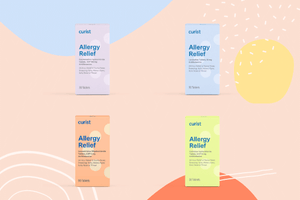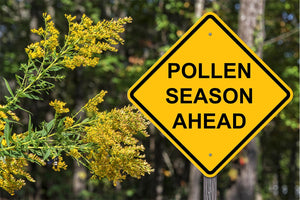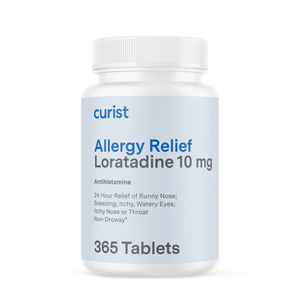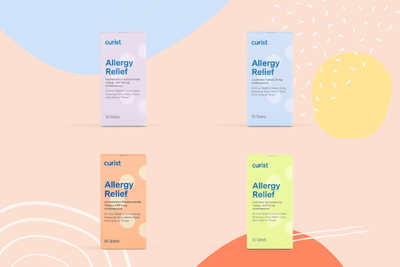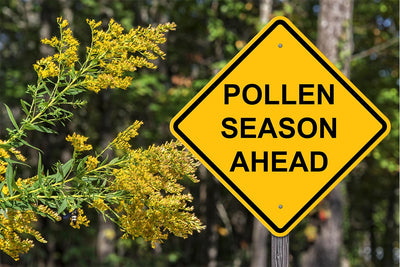By Amelia McGill, The University of Texas at Austin College of Pharmacy
Curist delivers over-the-counter medicines to your door at a fraction of the price of traditional brands. We hope everyone stays safe and healthy during this time.
Do you have allergy symptoms arising from mold? When seeking relief, does choosing from the numerous medications seem daunting? In this article, we clarify the causes of mold allergies and outline possible treatment strategies to help you mitigate or manage your mold allergies!
What are Mold Allergies? What are the Symptoms of Mold Allergies?
Mold allergies, also called allergic rhinitis or hay fever, is an allergic reaction triggered by inhalation of airborne mold spores. Mold, a natural microscopic fungus, thrives in environments with oxygen and moisture. Much like allergies caused by pollen or grass, mold allergies may be seasonally dependent. As seasons change and damp conditions become common, mold thrives, releasing mold spores that float through the air like pollen. From inhaling these mold spores, people can develop mold allergies.
Mold may also grow indoors, especially around warm, damp places such as a bathroom, basement, or attic. While some mold may be harmless, it is essential to identify mold species, as excessive exposure or specific types can harm your health. You can perform these tests using a certified company or at-home testing kit.
The symptoms of mold allergies can vary from person to person, and not everyone exposed to mold will be allergic. However, you may exhibit mold allergy symptoms if your immune system overreacts to mold spores. Mold allergies are treated the same as many other allergens. Symptoms may include:
- Itchy eyes, itchy nose, and itchy mouth
- Sneezing
- Watery eyes
- Stuffy nose (nasal congestion)
- Postnasal drip
- Headaches
- Open-mouth breathing
- Dark circles under the eyes (allergic shiners)
Symptoms can also include exacerbation of eczema or asthma symptoms. If these symptoms cause respiratory distress, or if you are a high-risk individual, seeking appropriate medical treatment is necessary.
How Do I Know If My Allergies are from Mold?
Distinguishing mold-induced allergic rhinitis versus allergic rhinitis caused by other sources can prove challenging. While symptoms are likely nearly identical, understanding triggers can be helpful.
Some indicators that suggest a mold allergy include:
- Symptoms worsen after rain.
- Symptoms appear after being in a damp environment, such as a basement.
- A history of mold in your home.
- Symptoms do not resolve after cleaning dust out of your home, avoiding animals, or avoiding food triggers.
- Visible growth of mold in your home.
- Positive allergy test done in a physician’s office.
Does Rain Make Mold Allergies Worse?
Yes, rain can make mold allergies worse. Mold spores thrive in wet conditions, thus rainfall can cause increased growth of mold, further aerosolizing mold spores. With an increase in airborne mold spores, allergy symptoms can worsen. If a rainy season is approaching, starting medication one week in advance can help minimize the development of symptoms and act as a prophylactic treatment.
What Treatment Options are Available for Mold Allergies?
Treatment options for mold allergies include reducing the allergen, over-the-counter medication, and, if necessary, prescription products. Non-drug treatment options include allergen avoidance. For example, cleaning a home of mold, using a HEPA filter or dehumidifier, and avoiding areas prone to mold growth outside.
Over-the-counter medication to alleviate mold allergy symptoms include antihistamines as the primary treatment. Antihistamines can be combined with intranasal corticosteroids or nasal decongestants to relieve symptoms, but will not cure an allergy. Side effects of antihistamines, depending on the generation, include dry mouth and drowsiness. Antihistamines should be taken routinely to get the maximum benefit, and you should not take more than one antihistamine at a time.
Nasal steroid sprays treat the symptoms of inflammation, itching, sneezing, and nasal congestion. The total effect may take up to 1 week, so combining an antihistamine with a nasal steroid is recommended for quicker relief. Examples of nasal steroids include Flonase (fluticasone), Rhinocort (budesonide), and Curist Allergy Nasal Spray (fluticasone propionate). Side effects can include nasal dryness and nosebleeds.
Decongestants are helpful agents to treat congestion caused by postnasal drip. Decongestants work by constricting blood vessels to increase the excretion of mucus. This will provide symptomatic relief of congestion, but should still be combined with an antihistamine. Decongestants are systemic (for the entire body) and topical (for a small part of the body, such as the eyes or nose). An example of a nasal decongestant is Afrin (oxymetazoline). Side effects of nasal decongestants include an increase in blood pressure and nasal decongestants should not be used for more than 3 to 5 days to avoid rebound congestion.
Allegra vs Claritin vs Zyrtec vs Xyzal vs Benadryl: What Can I Use to Treat Mold Allergy?
Numerous antihistamines are available to treat mold allergies. Antihistamines compete with the histamine-1 receptor, preventing histamine release, which is a chemical in your body that causes allergy symptoms.
Antihistamines are classified into generations: first-generation, which has sedating properties, and second- or third generation, which is nonsedating in most people.
|
Brand Name |
Generic Name |
Drowsiness Level |
Generation |
Duration of Action |
Curist Product |
|
Allegra |
fexofenadine |
None/Low |
3 |
24-hour |
|
|
Claritin |
loratadine |
None/Low |
2 |
24-hour |
|
|
Zyrtec |
cetirizine |
Low |
2 |
24-hour |
|
|
Xyzal |
levocetirizine |
Low |
2 |
24-hour |
|
|
Benadryl |
diphenhydramine |
High |
1 |
4-6 hours |
NA |
If you would like more in-depth differences on the first-generation antihistamines, check out the comparison of Allegra vs Claritin vs Xyzal vs Zyrtec to find what works best for you!
What are the Best Antihistamines for Mold Allergy?
The best antihistamine for mold allergies varies depending on individual preference. However, generally, the best antihistamine for daytime use is a non-drowsy option, such as Curist Allergy Relief (levocetirizine), or any other second- or third-generation antihistamine. For nighttime use, the best antihistamine is often a first-generation antihistamine, such as Benadryl, which provides more symptom relief and helps you sleep.
What’s the Best Allergy Medicine for Mold?
Finding the best allergy medicine for mold is a personal choice. While all regimens typically involve an antihistamine, you may consider the need for non-drowsy vs. drowsy antihistamine generations. Furthermore, depending on the area and severity of symptoms, you may want to add a nasal steroid or topical decongestant. Mold allergies can be challenging, but effective relief is possible.
One of the options we prefer as the best allergy medicine for mold is Curist Allergy Relief (levocetirizine 5 mg)!

